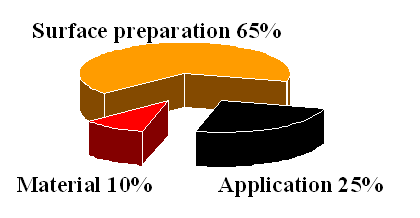
| 7. Coating Failures | |
|
7.1 Introduction |
|
Coating Failure
Coating failure is one which occurs within months or within years after the original application on exposure to environment. Coating failures may be of a minor nature requiring small repairs to catastrophic failures requiring recoating and which is more costly, more expensive and time consuming than the original job of coating. The determination of coatings can be controlled by inspection, monitoring and proper maintenance, where coating does not fail by a factor inherent in its constituents and formulation.
Coating failures may lead to very serious corrosion and operation problems with huge economic losses. Repairing a coating can be very hazardous and complex process when it involves working underwater, underground and working on bridges above water. The best strategy is to prepare a coating plan for a specified number of years and achieve the target by proper maintenance schemes. It may be better to leave a structure uncoated rather than to coat it badly as bad coatings as recoating may cost as much as thirty times the original cost of coatings. It is therefore important for engineers to understand the basic causes which lead to coating failures and the remedial measures which could be taken to avoid such failures. Learning from past mistakes is a good way to avoid costly mistakes in future.
Following table gives the contribution of important factors affecting the life of a paint system
|
Factor |
Share |
| 1. Application error | 46 % |
| 2. Incorrect specification | 41 % |
| 3. Change in environment | 11 % |
| 4. Faulty paint | 1 % |
Following graphs gives the breakdown in terms of surface preparation, material specification and application errors.

|
|